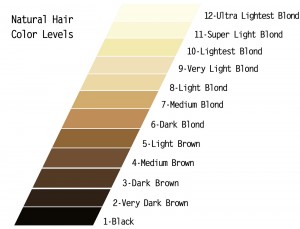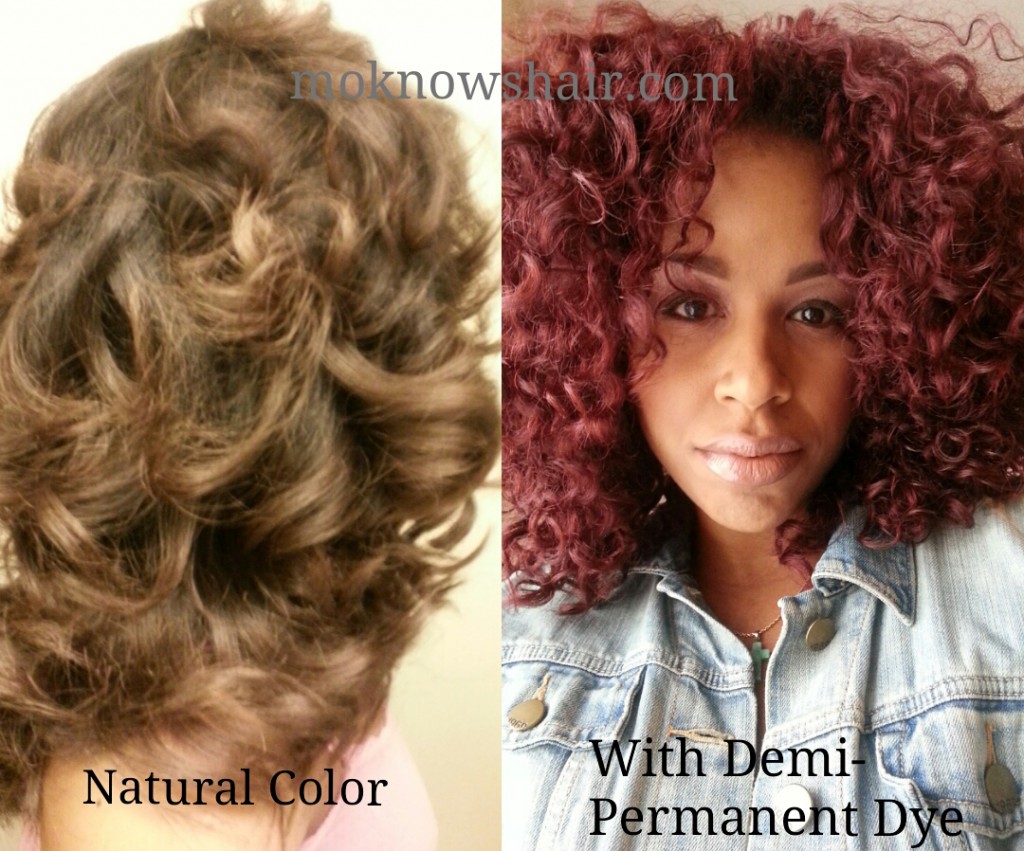
Changing your hair color is great way to create a new look. Bright reds and vibrant blondes are popular ways to spruce up your do, but there are some things you need to consider before altering the color of your hair.
Let’s start from the beginning. Hair is mostly made up of keratin, the same protein found in your skin and fingernails. The natural color of your hair depends on the ratio and quantities of two melanin pigments, eumelanin and pheomelanin. Eumelanin, which determines darkness of hair, makes brown to black shades. The amount of genes you have that produce this pigment is believed to be genetic. Pheomelanin produces lighter golden browns, blondes and reds. The absence of either melanin makes your hair white or gray (we lose melanin as we age, hence the reason hair grays with age).
Now, let’s look at two ways you can alter your hair’s natural color:
1. Temporary Hair Color
Semi-permanent dye deposits on the outside of the hair shaft. These products do not contain ammonia, meaning the cuticle isn’t opened during processing and the hair’s natural color and texture is retained once the color is washed out over time. These are often referred to as “rinses” or “tints.”
Demi-permanent dye lasts longer than semi-permanent, but eventually washes out over LOTS more time. These colors are ammonia-free and deposited using level 10 developer, which will not lift (lighten) or remove the natural hair color, but will slightly open the cuticle allowing color to deposit on top of your natural pigment.
Henna is a plant that grows in dry, hot climates. When its leaves are harvested, dried and powdered and then mixed with a mildly acidic liquid, it will stain skin, hair, and fingernails. Henna will not lighten the color of your hair, but it may tent. Henna is nearly impossible to remove from the hair without multiple color correction sessions with a stylist. It is not advised to use henna for hair coloring as it can cause other forms of damage to textured hair, especially if you will desire to alter your hair color in the future.
2. Permanent Hair Color
Traditionally, there are two main parts to a permanent color process that take place simultaneously. First, the outer layer of the hair shaft, the cuticle, must be opened before color can be deposited into the hair. Developer opens the cuticle so the dye can react with the inner portion of the hair, the cortex, to deposit the color. The level of developer used is determined by the desired color and how many “levels” of lifting it will take to achieve it.
Second, ammonia combines with the developer to remove the hair’s natural color (melanin) making it possible for the new, permanent color to bond to the hair’s cortex.
Bleach is often used as the first step in a double process to achieve very light shades on naturally dark hair followed by a toning process to remove brassy tones.
What you need to consider before choosing to dye your hair.
Porosity: How your hair absorbs and holds moisture will determine how color deposits in your hair. If you have low porosity, it can be more difficult to process dye because the hair shaft is not as receptive to foreign chemicals. This means if you are using a box kit, you may not get the color result as you see it on the packaging, which is why it is not advised to guess and possibly make a damaging mistake. If you have high porosity, you have to be careful not to over-process the hair as chemicals can process almost twice as fast. But, you can expect the color to fade slower. Also note, permanent dye will increase your hair’s porosity since it has to penetrate the cortex, making it harder for the hair to retain moisture in the future (which is why dryness can become an issue with high lift color or bleaching).
Texture: Coarse strands generally take more time to absorb color than fine width strands. This means the processing time and color level used will vary.

Your Natural Hair Color: There are levels to this. If you have level one or two, black/very dark brown hair, you will not make it to those light blondes and bright reds without the use of permanent dye, high-level developer and in some cases, bleaching agents.
Damage: Depending on the type of dye used and how many levels you have climbed up the color chart, you may experience differences in curl pattern, elasticity and overall manageability. This varies person to person. Some people have no problem at all with hair color and for others it’s a disaster. A good barometer is to think about your hair’s history. If you are prone to excessive shedding, dryness and breakage without color, expect those issues to get worse with it.

Looking at those kits on your favorite retailers’ shelves make it look so easy! But, you should know that dying your own hair when you are not completely knowledgeable about how chemicals interact is extremely risky. Also, hair dye is not a “one size fit all” process. No two people will get the exact same result because everyone’s hair is different. Using what you see others use or guessing can be a costly, damaging, irreversible mistake. This is not meant to discourage you from ever dying your hair, but to arm you with information you need to make a wise, conscious decision.
It is always my recommendation that you consult a professional colorist or stylist before making any decisions about chemically altering the color of your hair. And there’s no harm in visiting more than one salon to compare recommendations. So, find a few pictures of the color you want to show the stylist and ask these questions during your consultation:
- What color system do you use and are the maintenance products (shampoo, conditioner, etc.) available from the salon or in stores?
- Will the color I want require bleach? (If the answer to this is “yes,” you may consider another color as bleach can be difficult to maintain if you do not schedule regular salon visits.)
- Is it possible to achieve the color I want without the use of permanent dye (using demi- or semi-permanent)?
- What products are recommended to maintain the vibrance of the color and keep my hair healthy at home?
- How often will the color need to be touched-up?
- Are there any products/ingredients I should avoid once this color process is complete?
- How often will I need to return for touch-up and hair cut?
- Do you think my hair, as you can see it now, is in a healthy enough state to withstand this chemical process?
I hope this information gives you a better understanding of how dye works and how to approach your hair color transition!

I was thinking about dying my hair so this is good to know thank you.
This was very helpful. Your explanation and breakdown of the different types of dyes and developers was awesome. THANK YOU for posting this!
I have been natural for four years now. I decided to let my beautician to dye my hair yesterday. She used a developer 20 on my hair. My hair did not take. She told me to come back in a week from now. So she can attempt to recolor my hair. What is your advice for me?
Very soon this web site will be famous amid all blogging and site-building people, due to it’s good content
i want to dye my hair, but I am transitioning but i am concerned that my hair will become damaged. i believe that my natural hair texture is 4b with coarse strands and low porosity. what would be your advice?
DO you have any tips for going darker? I’ve never dyed my hair before and already have a natural dark brown but I would like to go black.
I mistakenly bought 20 volume liquid developer instead of cream, but heard I can still
use liquid. ? Can I mix/use it with black hair dye, my hair color is a dark brown.
i just dyed my hair but it didn’t turn out to be the color I wanted can I change it now or wait till its out then try to dye it again
I want this so bad I have dyed my hair like two weeks agocontent://media/external/file/1819
I also have natural medium brown hair
The benefits that are attached to using a bedwetting alarm are evident.
The Buddy Pen Pro is available exclusively in Australia
from Cheating the Hangman. Some people still
use natural remedies such as salt-water solution, humidifiers, and other
herbal concoctions.
Cheap vaporizers are floating everywhere yet being pretty active about their quality and services.
The herbs or tobacco you plan to use must first
be grinded into small bits and hydrated sufficiently for
the machine to work. It will increase the moisture in the air, making it much more bearable.
This was really helpful. I’m going to ask these questions when I go to get my hair colored 🙂
Luv ur hair! My question is I’ve been natural for 1 1/2 yrs. now and luv it but I have gray hair ESP in the front so I color just to cover it because it annoys me so. I’ve used in past Shea Moistures haircolor system which I loved but they stopped selling at Target and got to be too much $$ to order so I just changed to the One n Only Argan Oil system and I luv that too now because the color it turned my gray was medium copper on roots and I already had dark auburn on earlier dyes that turned hair like a fire red so my hair color has many hues to it because color turns gray into a brighter color than pkcg but still all beautiful. Now you may ask what’s my ? Well I constantly have to color gray because as soon as I color within 2 weeks I have gray again coming in and I just can’t believe my hair grows that fast as my friends have told me. These are permanent colors so I’ve always been waiting at least 2 months before applying more color to roots but still 2 wks later there’s new gray growth so what do u suggest? I used a color powder to cover it but u know these don’t last n just rubs off. Oh and did I mention I just luv ur hair?!!
BrowEffect is work awesome. I’ve been using it twice a day and it has lasted for a month. My brows are sprouting and growing, it’s pretty cool to see what a difference there is. If you want your eyebrows to grow don’t hesitate to order this product. It’s amazing and I highly recommend it.
i want to dye my hair, but I am transitioning but i am concerned that my hair will become damaged. i believe that my natural hair texture is 1b or a 2 with coarse strands and low porosity. what would be your advice?
I have natural highlights. I wanna dye my hair blond, but not permanently….just for the summer or winter….
My natural hair color is a mix between 1,2,3,4,5,6,7,8,9,10,11,and 12